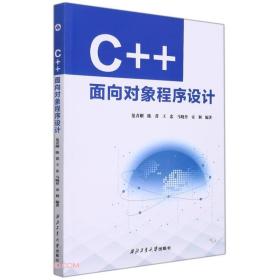
C++面向对象程序设计双语教程
正版保障 假一赔十 可开发票
¥ 22.18 6.2折 ¥ 36 全新
库存2件
广东广州
认证卖家担保交易快速发货售后保障
作者刘嘉敏[等]编著
出版社国防工业出版社
ISBN9787118103656
出版时间2014-04
装帧平装
开本16开
定价36元
货号8560779
上书时间2024-12-19
- 最新上架
商品详情
- 品相描述:全新
- 商品描述
-
目录
Chapter 1 Introduction
1.1 Overview of Programming
1.1.1 What Is Programming?
1.1.2 How Do We Write a Program?
1.2 The Evolution of Programming Language
1.2.1 Assembly and Machine Languages
1.2.2 Early Languages
1.2.3 Later-Generation Languages
1.2.4 Modem Languages
1.3 Programming Methodologies
1.3.1 Structured Programming
1.3.2 Object-Oriented Programming
1.4 Object-Oriented Programming
1.5 C + + Programming Language
1.5.1 History of CandC++
1.5.2 Learning C++
Word Tips
Exercises
Chapter 2 Basic Facilities
2.1 C++ Program Structure
2.2 Input / Output Streams
2.3 Constant
2.4 Functions
2.4.1 Function Declarations
2.4.2 Function Definitions
2.4.3 Default Arguments
2.4.4 Inline Functions
2.4.5 Overloading Functions
2.5 References
2.5.1 Reference Definition
2.5.2 Reference Variables as Parameters
2.5.3 References as Value-Returning
2.5.4 References as Left-Hand Values
2.6 Namespaces
Word Tips
Exercises
Chapter 3 Classes and Objects (Ⅰ)
3.1 Structures
3.1.1 Defining a Structure
3.1.2 Accessing Members of Structures
3.1.3 Structures with Member Functions
3.2 Data Abstraction and Classes
3.2.1 Data Abstraction
3.2.2 Defining Classes
3.2.3 Defining Objects
3.2.4 Accessing Member Functions
3.2.5 In-Class Member Function Definition
3.2.6 File Structure of an Abstract Data Type
3.3 Information Hiding
3.4 Access Control
3.5 Constructors
3.5.1 Overloading Constructors
3.5.2 Constructors with Default Parameters
3.6 Destructors
3.6.1 Definition of Destructors
3.6.2 Order of Constructor and Destructor Calls
3.7 Encapsulation
3.8 Case Study: A GradeBook Class
Word Tips
Exercises
Chapter 4 Classes and Objects (Ⅱ)
4.1 Constant Member Functions and Constant Objects
4.2 this Pointers
4.3 Static Members
4.3.1 Static Data Members
4.3.2 Static Member Functions
4.4 Free Store
4.5 Objects as Members of Classes
4.6 Copy Members
4.6.1 Definition of Copy Constructors
4.6.2 Shallow Copy and Deep Copy
4.7 Arrays of Objects
4.7.1 Initialize an Array of Objects by Using a Default Constructor
4.7.2 Initialize an Array of Objects by Using Constructors with Parameters
4.8 Friends
4.8.1 Friend Functions
4.8.2 Friend Classes
4.9 Case Study : Examples of Used-defined Types
4.9.1 A Better Date Class
4.9.2 A GradeBook Class with Objects of the Student Class
Word Tips
Exercises
Chapter 5 Operator Overloading
5.1 Why Operator Overloading Is Need
5.2 Operator Functions
5.2.1 Overloaded Operators
5.2.2 Operator Functions
5.3 Binary and Unary Operators
5.3.1 Overloading Binary Operators
5.3.2 Overloading Unary Operators
5.4 Overloading Combinatorial Operators
5.5 Mixed Arithmetic of User-Defined Types
5.6 Type Conversion of User-Defined Types
5.7 Examples of Operator Overloading
5.7.1 A Complex Number Class
5.7.2 A String Class
Word Tips
Exercises
Chapter 6 Inheritance
6.1 Class Hierarchies
6.2 Derived Classes
6.2.1 Declaration of Derived Classes
6.2.2 Structure of Derived Classes
6.3 Constructors and Destructors of Derived Classes
6.3.1 Constructors of Derived Classes
6.3.2 Destructors of Derived Classes
6.3.3 Order of Calling Class Objects
6.3.4 Inheritance and Composition
6.4 Member Functions of Derived Classes
6.5 Access Control
6.5.1 Access Control in Classes
6.5.2 Access to Base Classes
6.6 Multiple Inheritance
6.6.1 Declaration of Multiple Inheritance
6.6.2 Constructors of Multiple Inheritance
6.7 Virtual Inheritance
6.7.1 Multiple Inheritance Ambiguities
6.7.2 Trying to Solve Inheritance Ambiguities
6.7.3 Virtual Base Classes
6.7.4 Constructing Objects of Multiple Inheritance
Word Tips
Exercises
Chapter 7 Polymorphism and Virtual Functions
7.1 Polymorphism
7.1.1 Concept of Polymorphism
7.1.2 Binding
7.2 Virtual Functions
7.2.1 Definition of Vitual Functions
7.2.2 Extensibility
7.2.3 Principle of Virtual Functions
7.2.4 Virtual Destructors
7.2.5 Function Overloading and Function Overriding
7.3 Abstract Base Classes
7.4 Case Study: A Mini System
Word Tips
Exercises
Chapter 8 Templates
8.1 Template Mechanism
8.2 Function Templates and Template Functions
8.2.1 Why We Use Function Templates?
8.2.2 Definition of Function Templates
8.2.3 Function Template Instantiation
8.2.4 Function Template with Different Parameter Types
8.2.5 Function Template Overloading
8.3 Class Templates and Template Classes
8.3.1 Definition of Class Templates
8.3.2 Class Template Instantiation
8.4 Non-Type Parameters for Templates
8.5 Derivation and Class Templates
8.6 Case Study : An Example of the Vector Class Template
Word Tips
Exercises
References
内容摘要
由刘嘉敏、马广焜、常燕、朱世铁编著的《C++面向对象程序设计双语教程(第2版普通高等院校十三五规划教材)》从面向对象程序设计的特点出发,分章节循序渐进地介绍了面向对象的相关概念及运用C++实现的过程,并辅以大量程序清单。同时书中在各个章节起始处明确了章节学习目标,且在全书中重要
知识点处均有提示,各章末尾有本章出现的重要的词汇注解和本章相应的练习题,有助于读者理解书中内容,帮助读者掌握面向对象编程方法。全书共分8章,具体内容包括:导论、基本工具、类和对象(1)、类和对象(2)、运算符重载、继承、多态性和虚函数、
模板。
精彩内容
由刘嘉敏、马广焜、常燕、朱世铁编著的《C++ 面向对象程序设计双语教程(第2版普通高等院校十三五规划教材)》从面向对象程序设计的特点出发,分章节循序渐进地介绍了面向对象的相关概念及运用C ++实现的过程,并辅以大量程序清单。同时书中在各个章节起始处明确了章节学习目标,且在全书中重要知识点处均有提示,各章末尾有本章出现的重要的词汇注解和本章相应的练习题,有助于读者理解书中内容,帮助读者掌握面向对象编程方法。全书共分8章, 具体内容包括:导论、基本工具、类和对象(1)、类和对象(2)、运算符重载、继承、多态性和虚函数、模板。
相关推荐
— 没有更多了 —






















以下为对购买帮助不大的评价